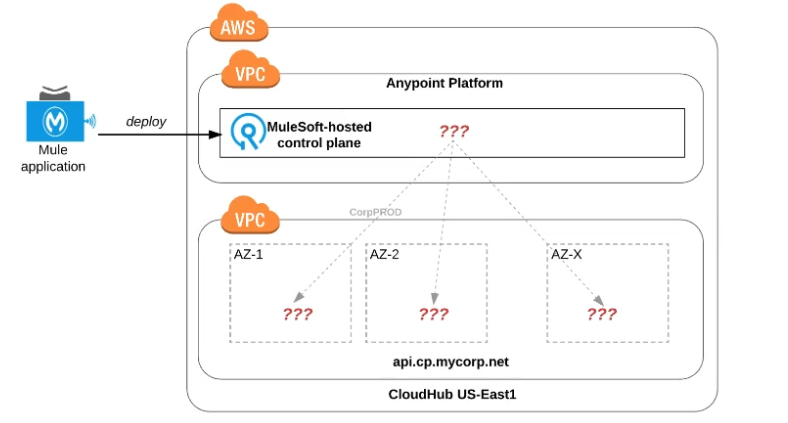MuleSoft MCPA-Level-1-Maintenance MuleSoft Certified Platform Architect - Level 1 MAINTENANCE Exam Practice Test
An organization wants MuleSoft-hosted runtime plane features (such as HTTP load balancing, zero downtime, and horizontal and vertical scaling) in its Azure environment. What runtime plane minimizes the organization's effort to achieve these features?
Answer : A
Correct Answer: Anypoint Runtime Fabric
*****************************************
>> When a customer is already having an Azure environment, It is not at all an ideal approach to go with hybrid model having some Mule Runtimes hosted on Azure and some on MuleSoft. This is unnecessary and useless.
>> CloudHub is a Mulesoft-hosted Runtime plane and is on AWS. We cannot customize to point CloudHub to customer's Azure environment.
>> Anypoint Platform for Pivotal Cloud Foundry is specifically for infrastructure provided by Pivotal Cloud Foundry
>> Anypoint Runtime Fabric is right answer as it is a container service that automates the deployment and orchestration of Mule applications and API gateways. Runtime Fabric runs within a customer-managed infrastructure on AWS, Azure, virtual machines (VMs), and bare-metal servers.
-Some of the capabilities of Anypoint Runtime Fabric include:
-Isolation between applications by running a separate Mule runtime per application.
-Ability to run multiple versions of Mule runtime on the same set of resources.
-Scaling applications across multiple replicas.
-Automated application fail-over.
-Application management with Anypoint Runtime Manager.
A company has started to create an application network and is now planning to implement a Center for Enablement (C4E) organizational model. What key factor would lead the company to decide upon a federated rather than a centralized C4E?
Answer : C
Correct Answer: When development is already organized into several independent initiatives
*****************************************
>> It would require lot of process effort in an organization to have a single C4E team coordinating with multiple already organized development teams which are into several independent initiatives. A single C4E works well with different teams having at least a common initiative. So, in this scenario, federated C4E works well instead of centralized C4E.
What Anypoint Connectors support transactions?
Answer : A
What Mule application can have API policies applied by
Anypoint Platform to the endpoint exposed by that Mule application?
A) A Mule application that accepts requests over HTTP/1.x

B) A Mule application that accepts JSON requests over TCP but is NOT required to provide a response

C) A Mute application that accepts JSON requests over WebSocket

D) A Mule application that accepts gRPC requests over HTTP/2

Answer : A
Correct Answer: Option A
*****************************************
>> Anypoint API Manager and API policies are applicable to all types of HTTP/1.x APIs.
>> They are not applicable to WebSocket APIs, HTTP/2 APIs and gRPC APIs
An API implementation is updated. When must the RAML definition of the API also be updated?
Answer : A
Correct Answer: When the API implementation changes the structure of the request
*****************************************
>> RAML definition usually needs to be touched only when there are changes in the request/response schemas or in any traits on API.
>> It need not be modified for any internal changes in API implementation like performance tuning, backend system migrations etc..
What is most likely NOT a characteristic of an integration test for a REST API implementation?
Answer : B
Correct Answer: The test runs immediately after the Mule application has been
*****************************************
>> Integration tests are the last layer of tests we need to add to be fully covered.
>> These tests actually run against Mule running with your full configuration in place and are tested from external source as they work in PROD.
>> These tests exercise the application as a whole with actual transports enabled. So, external systems are affected when these tests run.
So, these tests do NOT run immediately after the Mule application has been compiled and packaged.
FYI... Unit Tests are the one that run immediately after the Mule application has been compiled and packaged.
Refer to the exhibit.

An organization uses one specific CloudHub (AWS) region for all CloudHub deployments.
How are CloudHub workers assigned to availability zones (AZs) when the organization's Mule applications are deployed to CloudHub in that region?
Answer : D
Correct Answer:Workers are randomly distributed across available AZs within that region.
*****************************************
>>Currently, we only have control to choose which AWS Region to choose but there is no control at all using any configurations or deployment options to decide what Availability Zone (AZ) to assign to what worker.
>>There areNOfixed or implicit rules on platform too w.r.t assignment of AZ to workers based on environment or application.
>>They are completely assigned inrandom. However, cloudhub definitely ensures that HA is achieved by assigning the workers to more than on AZ so that all workers are not assigned to same AZ for same application.
Bottom of Form
Top of Form